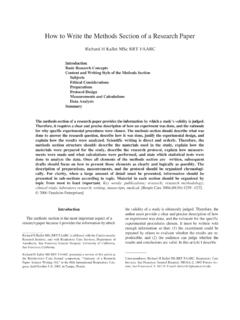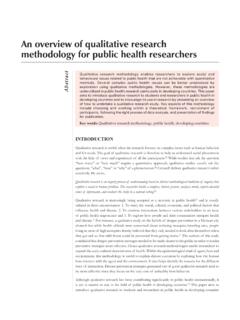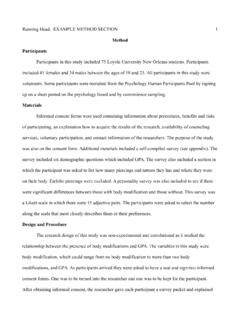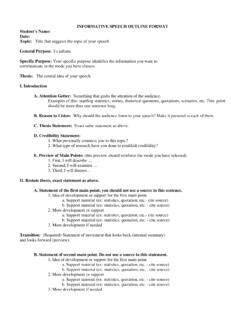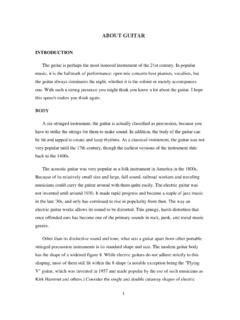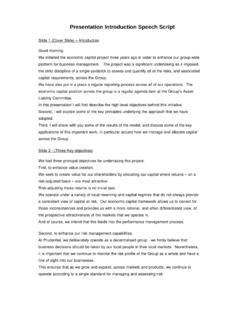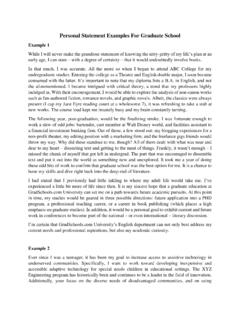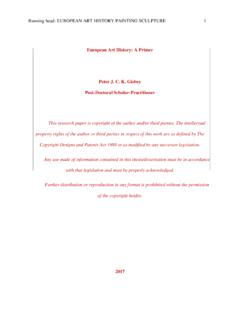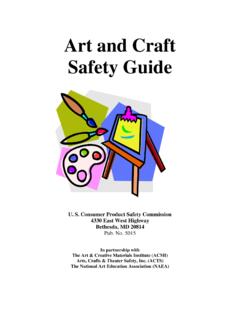Transcription of How to Write A Good Thesis Introduction | PDF Sample
1 1 Sample StructureUntil now, much of your science writing has focused on writing reports in which you simply described what you did and what you found. Although this will help you Write the central report sections (Methodology and Results) of a research paper or Thesis , it doesn t prepare you for writing an Introduction to a full-length research article; this is a new task that faces you once you move on to research practice, you will fi nd that you need to be certain about what you have done and what you have found in order to Write the Introduction , and so the best time to Write it will be aft er you have written, or at least draft ed, the report sections.
2 However, in this book, the structure of a research article is presented in the order in which it appears in a paper / Thesis so that you can trace the connections between each part and see the sequence in which information is presented to the may want to start your Introduction by describing the problem you are trying to solve, or the aim of your work, but as you will see when you examine published work, this is not how most research papers begin and therefore it is not the best way for you to begin. In order to help you Write the Introduction to your own research, the model you build must answer the following three questions: How do writers normally start the Introduction ?
3 What type of information should be in my Introduction , and in what order? How do writers normally end the Introduction ? 19/3/2009 2:26:55 PM9/3/2009 2:26:55 PMHow to Write a good Thesis Introduction2 SCIENCE RESEARCH WRITINGS ampleTh e fi rst thing you may notice about Fig. 1 is that it is symmetrical. Th is is because many of the things you need to do in the Introduction are done in reverse order in the Discussion/Conclusion. For example, you need to Write an opening sentence which enables you and your reader to get in or start your paper / Thesis and you also need to get out at the end of the Discussion/Conclusion by fi nding an acceptable way to end the paper / Thesis .
4 In addition, you must look for a way to interface with the central report section at the end of the Introduction , and again in reverse when you move out of the central section to start the else you should notice about the shape of the diagram is that it narrows towards the central report section, and widens aft er it. Th is represents the way information is ordered in the Introduction and the Discussion/Conclusion: in the Introduction you start out by being fairly general and gradually narrow your focus, whereas the opposite is true in the (what youfound/saw)METHODOLOGY(what you did/used)ABSTRACTINTRODUCTIONDISCUSSION/ CONCLUSION central report section Fig.
5 1. Th e shape of a research article or 29/3/2009 2:27:00 PM9/3/2009 2:27:00 PM 1. How to Write an Introduction 3 SampleTh e synthesis of fl exible polymer blends frompolylactide and rubberIntroduction1 Polylactide (PLA) has received much attention in recent years due to its biodegradable properties, which off er important economic benefi ts. 2 PLA is a polymer obtained from corn and is produced by the polymerisation of lactide. 3 It has many possible uses in the biomedical fi eld1 and has also been investigated as a potential engineering ,3 4 However, it has been found to be too weak under impact to be used One way to toughen polymers is to incorporate a layer of rubber particles5 and there has been extensive research regarding the rubber modifi cation of PLA.
6 6 For example, Penney et al. showed that PLA composites could be prepared using blending techniques6 and more recently, Hillier established the toughness of such 7 However, although the eff ect of the rubber particles on the mechanical properties of copolymer systems was demonstrated over two years ago,8 little attention has been paid to the selection of an appropriate rubber Th e present paper presents a set of criteria for selecting such a component. 9 On the basis of these criteria it then describes the preparation of a set of polymer blends using PLA and a hydrocarbon rubber (PI).
7 10 Th is combination of two mechanistically distinct polymerisations formed a novel copolymer in which the incorporation of PI signifi cantly increased fl the Introduction below. Don t worry if the subject matter is not familiar or if you have diffi culty understanding individual words, especially technical terms like polylactide. Just try to get a general understanding at this stage and familiarise yourself with the type of language 39/3/2009 2:27:00 PM9/3/2009 2:27:00 PM4 SCIENCE RESEARCH Grammar and Writing SkillsTh is section deals with four language areas which are important in the Introduction :TENSE PAIRSSIGNALLING LANGUAGEPASSIVE/ACTIVE Tense pairsPresent Simple/Present ContinuousIn order to use tenses correctly in the Introduction , you fi rst need to look at the diff erence between the way the Present Simple tense and the Present Continuous tense are at these two sentences.
8 (a) I live in Simple(b) I m living in Continuous(a) describes a permanent situation and (b) describes a temporary situation. Because of this, the Present Simple tense is used in science writing to state accepted facts and truths but what qualifi es as an accepted fact or truth is oft en, surprisingly, your decision. Sometimes the writer considers that research fi ndings have the status of a fact; in that case, s/he can decide to state them in the Present Simple, usually followed by the appropriate research reference. Here is an example from the Introduction in Section :5 One way to toughen polymers is to incorporate a layer of rubber particles5 and there has been extensive research regarding the rubber modifi cation of 49/3/2009 2:27:00 PM9/3/2009 2:27:00 PM 1.
9 How to Write an Introduction 5 SampleLater on, in the Results section, you can even decide to state your own fi ndings this way. Look at these two sentences which describe results:(a) We found that the pressure increased as the temperature rose, which indicated that temperature played a signifi cant role in the process.(b) We found that the pressure increases as the temperature rises, which indicates that temperature plays a signifi cant role in the sentence is stronger ? In (a), using the Past Simple tense means that your fi ndings are linked only to your own research, and you do not claim your deductions should be considered as accepted or established facts, or even that another researcher will necessarily get the same results.
10 In (b), using the Present Simple tense means that you believe your fi ndings and deductions are strong enough to be considered as facts or truths. Th e Present Simple communicates this reliability and your readers will respond to your work accordingly. Th ere will be more about this later, in the unit on Simple/Present PerfectAnother tense pair you need in the Introduction is the Past Simple tense and the Present Perfect tense. You will need both, and you need to know when and why to switch from one to the other. Look at these sentences:(a) Past Simple: I lived in Tokyo for fi ve but I don t live there anymore.
